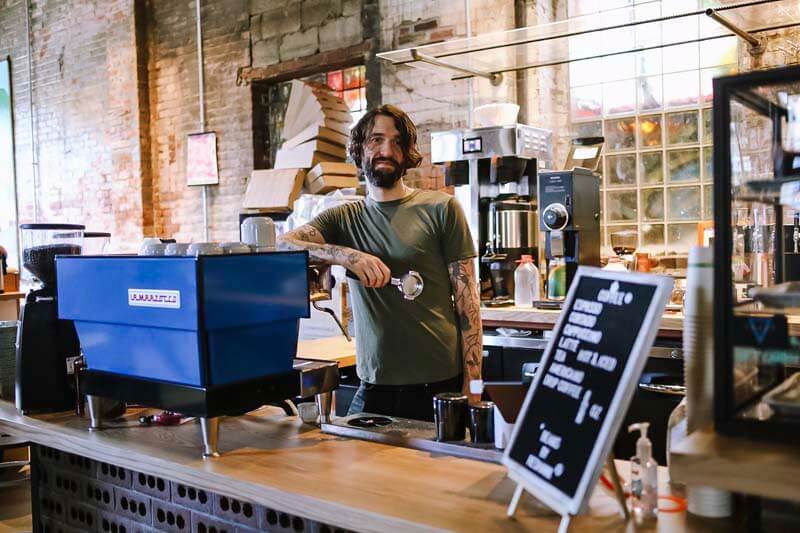
Over the last several years more breweries have gotten serious about coffee. Those like Night Shift Brewing, Moksa Brewing, Modern Times Beer, Wooden Robot Brewery, Aslin Beer Company, and Trace Brewing, among many others, have either built out their own coffee bars on site, started selling their own bags of coffee, or even in a few cases roasted their own beans in the brewery.
It’s really not a huge surprise considering craft beer and craft coffee share a lot in common. They both involve “brewing” and they’re both craft products made by craft producers.
In fact, on Untappd’s list of the highest-average rated beer styles of 2022, imperial coffee porters tied for seventh with a rating of 4.1 and imperial coffee stouts made it all the way to second place with an average rating of 4.16 out of five on the app.
Without a doubt, consumers are buzzing as much for coffee in their afternoon glass as their morning cup.
In September 2022, the National Coffee Association reported that young adults in the U.S. are drinking coffee more than ever before. According to the National Coffee Data Trends report, sixty-six percent of Americans over eighteen drink coffee, a two-decade high first reached in January 2022.
“Continuing its decades-long reign as America’s favorite beverage, coffee is also reaching new heights among young adults,” NCA President and CEO William “Bill” Murray commented in a press release. “The NCDT’s latest snapshot of consumer behaviors and attitudes reaffirms both coffee’s popularity and its resilience, as coffee drinkers continue to brew through challenges like the COVID-19 pandemic and economic uncertainty.”
With coffee just as popular as if not more than beer, you should consider why it might be beneficial to introduce a coffee bar at your brewery.
(Above photography courtesy of Julie Kahlbaugh / Trace Brewing)
What We’ll Cover in This Piece:
Affordable, Industry-Leading Brewery Software
The Three Reasons to Start a Coffee Bar at Your Brewery
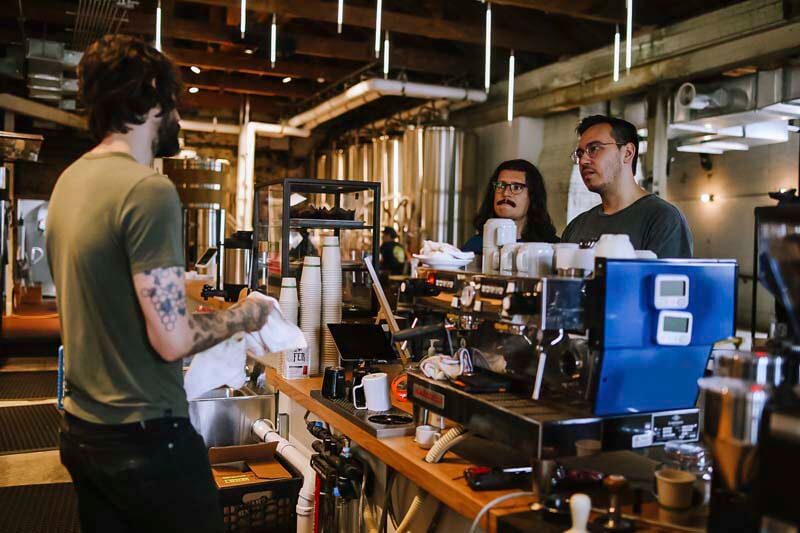
Photography courtesy of Julie Kahlbaugh / Trace Brewing
Here are a few reasons why you should consider starting a coffee program in your taproom.
1. Activate Your Taproom All Day
We’ve already mentioned that the number of Americans who enjoy a cup of Joe has risen to its highest level in the past two decades.
But perhaps even more importantly, the National Coffee Data Trends found that these drinkers are actively leaving their home to search for java.
The report discovered that fifty-six percent of those who drink coffee bought their cups away from home at least one-to-three times per week while thirty-three percent reported trekking outside their home to buy their morning Joe at least four times per week.
If Americans are continuing to look in their local communities for their jolt of caffeine, building a coffee bar at your brewery allows you to capture this demographic.
Think about it: What time do you currently open to start pouring beer? Noon? 3pm? Later?
“Most breweries I sense don’t open until later in the day, so that early part of the day it’s just sort of space,” says Joe Burns, head of coffee at Trace Brewing in Pittsburgh, PA. “What Trace has done is opened up that space to the community for the entirety of the day. It’s definitely a meeting space for the entire community now…open in the very early morning to closing very late at night.”
The coffee bar was a part of the build-out from the very beginning when Trace opened in 2020.
It’s a strategy that has contributed to the overall vibe and mission of the brewery to be a community space for all.
“It’s not uncommon to look up and see dozens of people hanging out working on laptops just as you would in any other coffee shop,” says Burns, who has been working in specialty coffee for about fourteen years. “At some point during the day the lights dim, people close their laptops, and switch from coffee to beer.”
Trace can keep the space activated all day whether that’s just bringing in coffee drinkers in the morning, those that stick around to drink different beverages all day, or straight up beer fans at night.
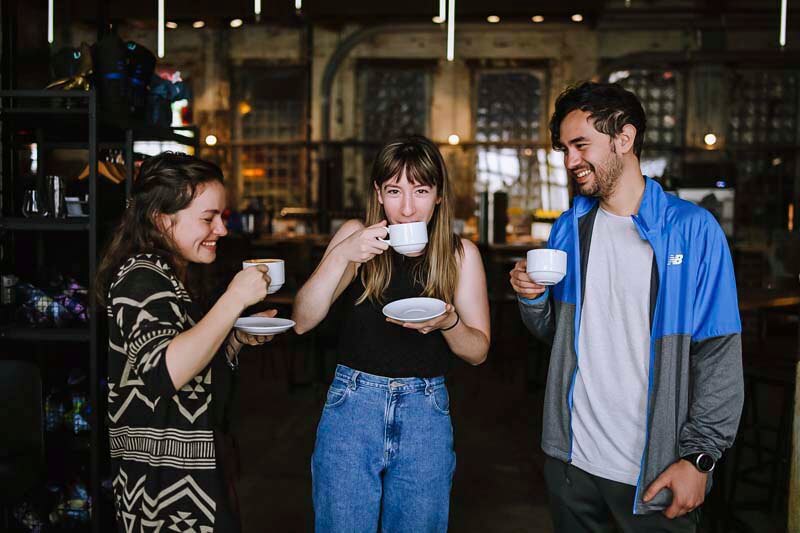
Photography courtesy of Julie Kahlbaugh / Trace Brewing
2. Bring a New Demographic Into Your Taproom
To that point, having a coffee program inside the brewery lets Trace attract an entire new clientele.
“I think a big advantage is you’re not isolating people,” says Burns. “You have an entirely separate non-alcoholic beverage program that can bring people into your space and welcome different people into your space to hangout.”
Many breweries nowadays are learning the ins and outs of brewing non-alcoholic beer, marketing non-alcoholic beer, or even making hop waters. All in the pursuit to provide an offering to those interested in NA options.
But have these breweries skipped over an NA drink that has been around for centuries really?
As we’ve already shown, coffee has continued to be one of the most popular beverages of choice for Americans and those around the world.
Exploring a coffee program is a different way to provide a non-alcoholic option for your current fans and bring in completely new ones.
“It expands your community,” says Burns. “At Trace I try to keep us extremely involved in the local community… I try to invite as many different coffee people into the space as possible.”
Whether that’s through monthly latte art throwdowns or Pittsburgh Coffee Week. And according to Burns, it’s working. “It’s a way to celebrate different communities and a different industry,” meaning you’re bound pretty much by the laws of physics to bring more folks into your space if you invest in coffee.
3. Have Craft Coffee at Your Fingertips for Your Beer
As we’ve already mentioned, coffee beer styles have become extremely popular.
While iconic versions of coffee beers have emerged, including Founders Brewing Breakfast Stout, Three Floyds Dark Lord, and Toppling Goliath’s Mornin’ Delight, to name a few, almost every brewery nowadays has experimented with adding coffee to one or two beers.
“There is a huge crossover between the two industries,” says Burns. “I’m frequently surprised when I’m talking to brewers at Trace [about how] they’re thinking about and approaching beer… A lot of what they’re doing is very similar to how I’m thinking about and approaching coffee.”
The overlap of these two industries has opened up an interesting space for experimentation.
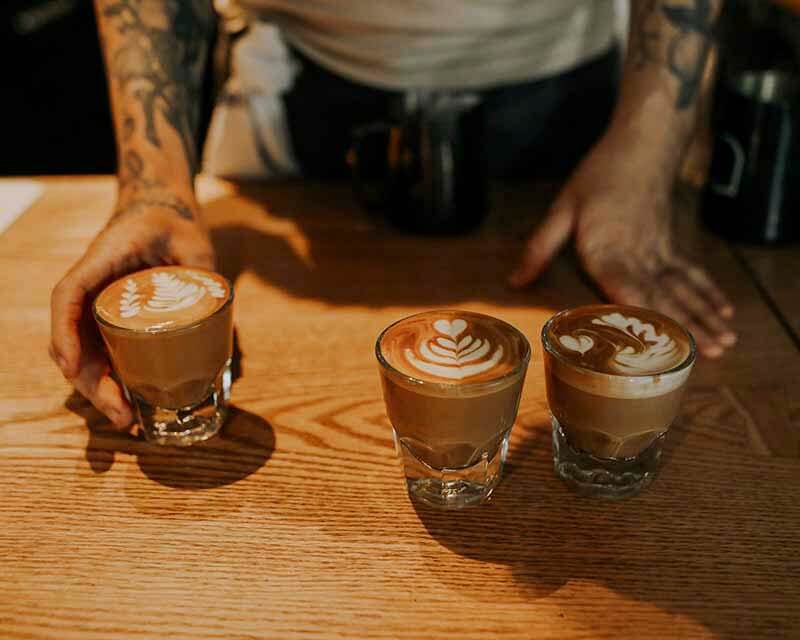
Photography courtesy of Julie Kahlbaugh / Trace Brewing
If you have a coffee program at your brewery, you can bring in someone to run it like Burns who has a vast amount of experience and knowledge. Not only will you have carefully curated coffee to use in your own beers, but you will also have a savant to help you improve your own recipes. (We have a few tips too in our “Essential Guide to Brewing Coffee Beers.”)
Are you hopped up to learn more about what it takes to run a coffee bar in your brewery?
The First Step to Building a Coffee Bar at Your Brewery
If starting a coffee bar at your brewery sounds interesting, there are quite a few considerations.
First and foremost, you need to understand exactly what apparatuses you’ll need and the cost of that equipment.
We’re going to be transparent here: The machines and utilities you need for a coffee bar are costly. But it’s no different than the investment you make for the equipment in your brewhouse.
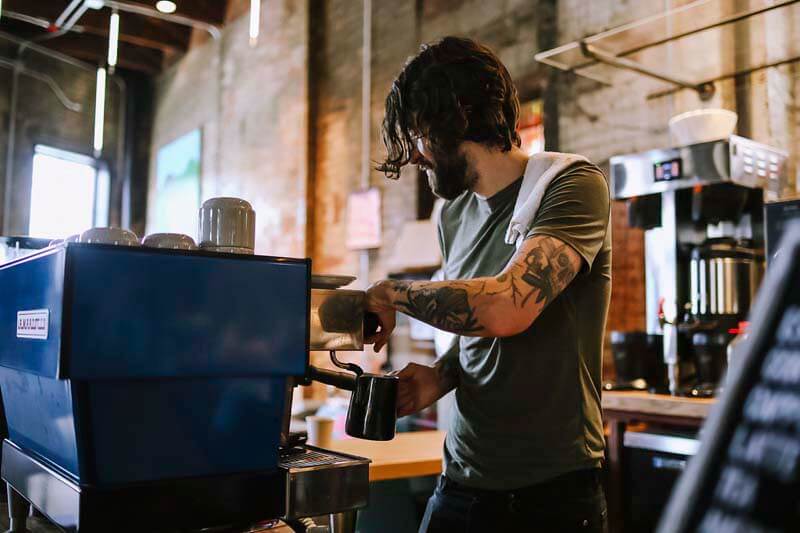
Photography courtesy of Julie Kahlbaugh / Trace Brewing
According to Burns, at a minimum you’ll need the following:
- Espresso machine
- Grinder
- Batch brewer
- Tower brew for drip coffee
- Separate grinder for that tower brew
- Reverse osmosis system or water softener for those machines
- Power and plumbing
- A source of beans
- Supplies (cups, lids, straws, stirrers, napkins, sugar and creamer packets, flavorings or syrups, baked goods, dairy and non-dairy products, etc.)
You’ll need to decide for yourself whether investing in a coffee bar makes sense. With that in mind, it will probably help to understand the exact cost.
The Cost of Creating a Coffee Bar at Your Brewery
The equipment, supplies, and materials you need for a legitimate coffee bar aren’t cheap.
Burns says that for the espresso grinder, batch brewer, tower brew, and separate grinder, “right there, you’re talking a minimum of $20,000 for a decent setup.”
If you dole out for even higher top-of-the-line roasters and equipment, you can probably reasonably expect to pay closer to $50,000 out of pocket.
You also need to recognize there will be costs associated with hiring and maintaining a staff to run the coffee bar.
And that it may take a while for the coffee program to fully run on all cylinders.
Currently, at Trace the coffee bar sells about 80-100 coffee-related items, according to Burns. “A busy day for us right now with coffee is hitting between $300-$400 in sales,” he says. “It’s been trending up as our guests discover that we have a coffee bar. I’m hoping that continues throughout the year!”
How to Find the Right Equipment for Your Coffee Bar
If all this means you’re still on board, one of the first things you’ll need to do is find all the furnishings.
Burns recommends reaching out to local coffee equipment providers. He says you can purchase equipment online, but hedges against that approach.
“I would really recommend you find the closest espresso supply company to you because they will also be the people who most likely end up installing your machine and servicing it in the event something goes wrong,” he says. “You want to find your local espresso supply company and make good friends with them.”
Additionally, while not a complete one-stop shop, your local coffee equipment provider will stock most everything from brewers to grinders and everything in between.
How to Source Beans for Your Coffee Bar
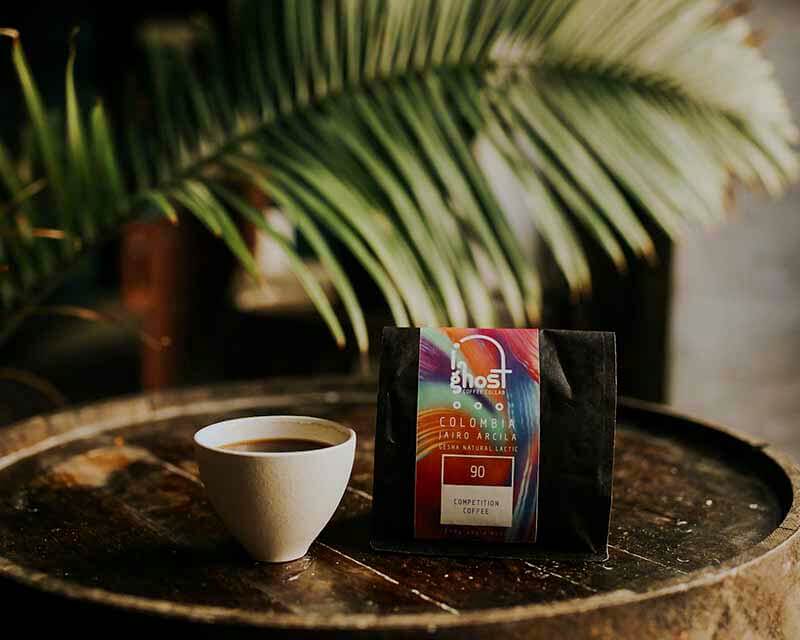
Photography courtesy of Julie Kahlbaugh / Trace Brewing
You can’t brew coffee without decent beans.
Here again Burns recommends looking for a wholesale coffee provider as a partner. “Every major city has so many different coffee roasters these days,” he says. “You can pick one that appeals to you.”
To find a good fit, Burns says you should reach out to roasteries and ask for samples. “Most are super interested in cupping coffee, showcasing their product, and talking to you about what they like,” he says. “Most of them have different theories, different philosophies, and different approaches to coffee, so find one that matches your personal interest.”
This is probably the most fun part of building out a coffee bar in your brewery along with building out your menu.
How to Build Out a Menu for Your Coffee Bar
Your coffee menu will depend on your own preferences.
At Trace, Burns takes a pretty modern approach to their menu but with a traditional foundation.
They ethically source all of their high-quality coffee, featuring lighter roasts than you’ll see at traditional coffee shops. But Burns presents the drinks themselves in a more traditional way.
“I designed the menu to be what I enjoy in coffee shops,” he says. “I like to see modern approaches to traditional drinks. To me a cappuccino is a single-sized drink 5-6 oz; it’s not something you can order in small, medium, or large, so when I put cappuccino on the menu it’s a single-size drink.”
Same thing with a latte. Which is why you’ll find both on Trace’s menu only offered in a single size. (The bonus to this approach is that you only need to buy one cup size.)
The National Coffee Data Trends report found that the top three most popular specialty coffee beverages are lattes (17%), espressos (16%), and cappuccinos (15%).
So at the very least, your coffee menu should include those traditional drinks along with drip coffee.
But if you want to expand beyond that, it’s up to you.
And cold coffee should be a consideration as well. Thirty percent of past-day coffee drinkers had cold coffee, according to the National Coffee Data Trends findings.
Although Burns cautions that including a cold option should depend on where you are in the country and the season.
In Pittsburgh, Burns actually takes their cold brew off the menu in the winter when it’s icy and snowy because sales drop off dramatically. He’ll throw it back on in summer when demand returns.
How to Set Up your Coffee Bar
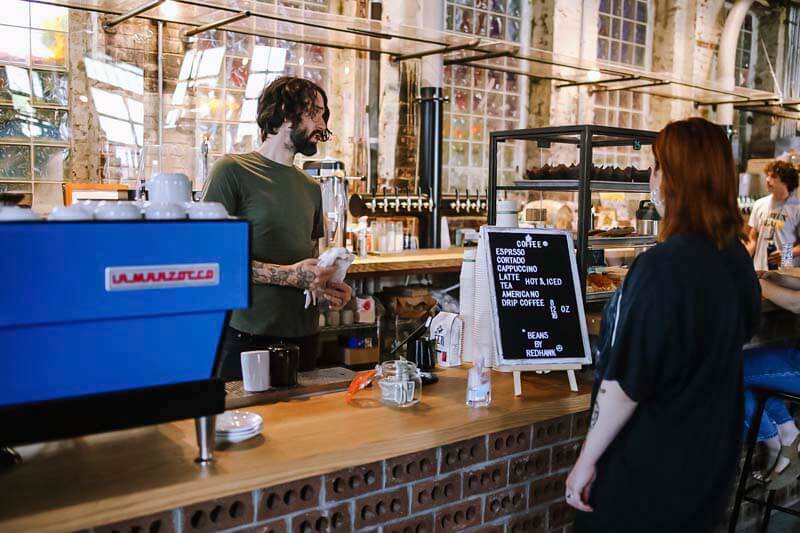
Photography courtesy of Julie Kahlbaugh / Trace Brewing
Now that you bought the right equipment, designed a menu, and found beans to brew, you’ll need to figure out how to set up your coffee bar.
Obviously, this will vary brewery to brewery depending on the space you have available.
At Trace, the coffee bar is extremely small, about a 6ft space.
“The way we have it set up is that the espresso machine is on the bar, grinder next to the espresso machine, and I’m interacting with customers next to the espresso machine,” says Burns. “On the back bar behind me is where you have the grinder, the tower brewer, and that sort of stuff.”
The important thing to keep in mind here is that you will need access to water and electricity to power everything.
“You have to run electricity, you have to run water, you need drains, depending where you are different health departments have different requirements for coffee shops,” says Burns, noting they had to put in a grease trap for the coffee bar at Trace.
It’s best to connect with your local health department to better understand all the regulations and specifications you’ll need in your area for your own coffee bar.
The Three Things You Can’t Forget When Starting a Coffee Bar
It was an interesting exercise to chat with Burns about starting a coffee bar in a brewery because the more we talked the more small details emerged that he realized were important to share.
We mined his mind, so you don’t have to.
Here are the three things he says you can’t forget about when starting a coffee bar at your brewery.
1. Find a Bakery Partner
How often do you walk into a coffee shop and just buy coffee?
Maybe you do, but most people expect to at least have the option of buying a baked good to pair alongside that latte or cappuccino.
Bottom line: People expect baked goods when they walk into a coffee shop. Burns recommends you provide some even if it’s just a small selection.
Trace partnered with a local bakery that delivers their baked goods a couple of times a week.
2. Find a Dairy Provider
In that same vein, make sure that you have dairy and non-dairy options on hand.
“Are you going to offer alternative milks?” says Burns. “It can cascade out of control very quickly.” Which is why Burns keeps it very simple at Trace; He offers only dairy milk and oat milk.
“At the end of the day I’m not sure it matters very much to your bottom line if you choose one milk versus another,” says Burns. “I don’t know that the average person can taste the difference, but I can, so that’s important to me.”
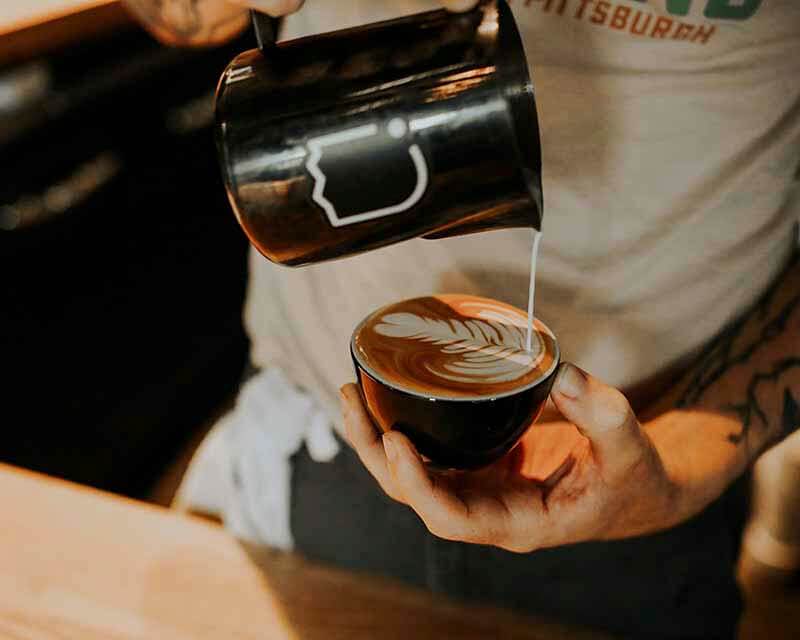
Photography courtesy of Julie Kahlbaugh / Trace Brewing
Regardless, at least having one or two milk options will be beneficial to your customers.
When it comes to all the “peripheral coffee stuff that you can find in coffee shops,” says Burns, such as paper cups, packets of sugar, lids for paper cups, pastry bags, cup sleeves, and syrups, it’s best to work with an espresso service company or coffee supply company.
3. Hire the Right People
It’s crucial to find someone to run your coffee program who is knowledgeable and attentive.
“Coffee is an easy thing to do well, but it’s an easier thing to do very poorly,” says Burns, who previously worked as the director of coffee for a roastery in Pittsburgh doing all the coffee sourcing, coffee roasting, menu planning, and barista training. “You can get as complicated and as involved with it as the beer industry does with beer.”
Hiring the right people, who have experience working in a coffee shop, roasting, or in other areas of the industry will only help you later on down the road.
Will You Go Down the Rabbit Hole of Coffee?
At the end of the day (or should we say the beginning of the morning), adding a coffee bar in your taproom can bring in not only more clientele but also a more diverse clientele and can also activate your space for the entire day.
It’s also an opportunity to delve deep into a craft product like coffee that is as complex as beer.
“[I can go] as far down the rabbit hole as I want to go,” says Burns. “I haven’t found the bottom yet.”
Brew Better Coffee Beer With Ollie
A brewery management tool built by brewers and for brewers. Handle everything in your brewhouse from recipe development to cost management. All with one easy-to-use platform. Ready to get back to brewing better beer? Get Ollie Ops or Ollie Order.



